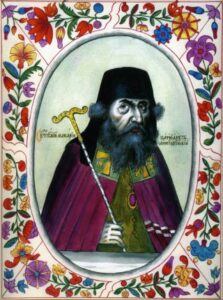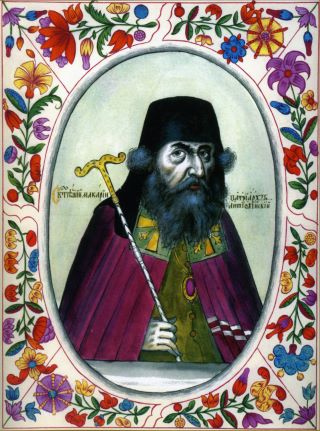
Editor’s note: Today, nine Orthodox Churches consecrate their own Holy Chrism: Constantinople, Moscow, Serbia, Romania, Bulgaria, Georgia, the Orthodox Church in America, the Macedonian Orthodox Church (or whatever you want to call it), and the Ukrainian Orthodox Church. The rest of the autocephalous churches – the ancient patriarchates of Alexandria, Antioch, and Jerusalem, the ancient Church of Cyprus, and many of the “newer” autocephalies like Greece, Albania, and Poland – receive their Holy Chrism from Constantinople. For the newer autocephalous churches, the reception of chrism from Constantinople was part of the deal when they received recognition of autocephaly from the Ecumenical Patriarchate. But what about a church like Antioch, which is older than Constantinople itself? Why do they receive chrism from the EP? When did this start, and is there any good reason today why Antioch shouldn’t resume consecrating chrism for itself?
Canon 6 of the Council of Carthage of 418-419 prohibits presbyters from consecrating chrism. Although there is no canonical prohibition for any bishop to consecrate it, it became the custom for only patriarchs (and much later, primates of autocephalous churches in general) to consecrate chrism during Holy Week. Part of the reason for this was the value of this relatively rare occurrence involving the patriarch surrounded by many of his bishops, as a sign of unity. Another major factor, however, was the increasingly elaborate nature of both the ritual itself and the recipe used, which came to involve a large variety of rare and costly ingredients.
At least in the period following the Muslim conquest of Antioch (if not earlier), the patriarchs of Antioch maintained that they had at one point held the exclusive right to consecrate chrism for the entire Church. This may be due to the fact that the ritual of consecrating chrism by bishops originated within the territory of the Patriarchate of Antioch or it may be due to Antioch’s better access to the necessary ingredients. This right is mentioned repeatedly by Nikon of the Black Mountain in his Taktikon, written towards the end of the 11th or beginning of the 12th century. In Logos 31 of the Taktikon,[1] an autobiographical and historical letter to his “spiritual brother” Basil, Nikon states:
“The holy chrism was in the beginning not consecrated elsewhere [than Antioch]. In the history book of which I spoke earlier, it is written in the Acts of the Council of Chalcedon: ‘It was decided that chrism was to be consecrated everywhere; for it was consecrated first only by the [patriarch] of Antioch. But as it became known that it was given for gifts, it was decided that it should be consecrated by bishops no matter where.”[2]
Such a decision is not found in the extant acts of the Council of Chalcedon, and the apparently no-longer-extant “history book” that Nikon repeatedly refers to in this letter has not been identified.
The issue of chrism is raised again in Logos 37,[3] a letter to his spiritual son the monk Gerasimus, which discusses Antioch’s granting autocephaly to the Georgians during the time of the Patriarch Theophylactus bar Qanbara (r. 745-751). Here Nikon again states that “It was the custom [τύπος] for chrism to be consecrated in Antioch and from there it was sent to all the world, for nowhere else did anyone consecrate chrism.”[4]
This was especially important for the Patriarchate of Antioch’s relationship to Georgia, because the patriarchate had extensive landholdings there where the spices for chrism were cultivated, providing substantial annual revenue. In explaining how Antioch decided to grant the Georgian Church the right to produce its own chrism, Nikon again cites the text attributed to the Acts of the Council of Chalcedon.[5] As part of the agreement for Georgia’s autocephaly, the Georgians were to pay one thousand nomismata annually in exchange for the ingredients for holy chrism. This arrangement seems to have been connected to the difficulties of financing a patriarchate under Muslim rule, since once Antioch found itself again under Byzantine rule in the late 10th century, this revenue was transferred to the Patriarchate of Jerusalem, which was suffering severe persecution under the Fatimids.
Nikon’s account is confirmed by his contemporary, St Eprem Mtsire, in his Report on the Reasons for the Georgians’ Conversion, written in Georgian on the Black Mountain near Antioch, who evidently makes use of the same sources.[6]
Knowledge of Antioch’s prerogatives regarding chrism seems to have been widespread, at least during the 10th and 11th centuries. An anonymous Nestorian chronicler (probably the same author as that of the Chronicle of Seert), writing in Baghdad in the 10th century, states when discussing the “Western” patriarchates that the Patriarch of Antioch “is the one who consecrates the chrism and sends it to his counterparts.”[7]
Production of chrism only started to be centered in Constantinople with the Crusader occupation of Antioch and Jerusalem, when nominal patriarchs of Antioch and Jerusalem were appointed and resided in the Byzantine capital. There does not seem to be any evidence that there was ever any formal assigning of such a right to Constantinople.
The Patriarchate of Alexandria, however seems to have continued to consecrate its own chrism during this period. The published version of the Greek text of the “Melkite” (that is, Middle Eastern Chalcedonian) rite for consecrating chrism, which was very distinct from the Constantinopolitan rite used today and similar to the rites used in the Coptic and Syriac Churches, is from a liturgical scroll copied in Alexandria in the 12th century.[8] Another source for the preparation of chrism among Melkites in Egypt is the 14th century manuscript Paris, Bibliothèque Nationale, Arabic 236, a canonical collection which at its beginning has three different, relatively simple, recipes for preparing chrism.
After the patriarchs of Antioch returned to Antioch in the 13th century, and then moved to Damascus in the second half of the 14th, they once again consecrated their own chrism.
In the early Ottoman period, the preparation of chrism in Antioch was rare enough to be noteworthy, since due to the great difficulty and costs associated with obtaining and preparing the ingredients, when the ritual was performed, enough chrism would be produced to last decades.
Paul of Aleppo notes that the Patriarch Joachim ibn Ziyada consecrated chrism on Holy Wednesday of 1594.[9]
When the Patriarch Macarius returned to Damascus after his first journey, in 1660, he discovered that very little of the chrism prepared by Joachim ibn Ziyada remained, so he began preparations to produce new chrism. Paul of Aleppo provides the precise recipe, which included an enormous variety of spices which were prepared in five stages over the course of Holy Week. A local Damascene priest, Hanna ibn Rizqallah, even composed a lengthy poem celebrating the event.[10]
Patriarchs of Antioch not only consecrated chrism for their own flocks, but also did so for other bishops when travelling:
In 1653, the Patriarch Macarius prepared chrism at Iași, using ingredients that he had brought from Constantinople. His son and archdeacon, Paul of Aleppo, describes how they had begun to pound the ingredients at the beginning of Lent, then beginning to boil them from Holy Monday through Holy Thursday, with the patriarch, bishops and priests constantly reading the Gospel around the fire. The procedure was completed finally on Holy Thursday, with the addition of “balsam oil, musk, amber, incense wood, and other precious ingredients.”[11]
On his second journey to Moscow, in 1667, Macarius also prepared chrism, together with the Patriarch of Alexandria.[12]
Consecration of chrism in Antioch continued after the 1724 schism that led to the creation of the Melkite Catholic Church. The Damascus priest and historian, Mikhail Breik notes that upon his return from Moldavia in 1750, the Patriarch Sylvester prepared chrism, in the presence of “two bishops, seventeen priests and nine deacons, in addition to the monks and all the chanters.”[13]
Antioch only seems to have started receiving chrism from Constantinople following the death of Sylvester, when he was succeeded by a series of Greek patriarchs who, unlike him, had no real connection to the patriarchate and its people. Thus, there is no canonical, theological or traditional justification for Antioch’s current custom of receiving chrism from Constantinople, which seems to have come about only in the second half of the 18th century at the earliest, seemingly due to economic factors. (Notably, the Melkite Catholic Church has never ceased consecrating its own chrism.)
Given Antioch’s long history and close connection with the consecration of chrism, only broken relatively recently (in Church-historical terms), and given the easier availability of the ingredients, today it would be appropriate for Antioch to return to its traditional practice of consecrating its own chrism.
Endnotes
[1] Translation and Greek text in Willem J. Aerts, “Nicon of the Black Mountain, Witness to the First Crusade? Some Remarks on His Person, His Use of Language and His Work, Named Taktikon, esp. Logos 31,” in K. Ciggar and M. Metcalf, East and West in the Medieval Mediterranean I: Antioch from the Byzantine Reconquest until the End of the Crusader Principality (Leuven: Peeters, 2006), 125-169.
Critical edition of the Greek and its Slavonic translation in Christian Hannick et al., Das Taktikon von Nikon vom Schwarzen Berge. Griechischer Text und kirchenslavische Übersetzung des 14. Jahrhunderts (Freiburg: Weiher, 2014), vol. 2, 810-827.
[2] Translation very lightly adapted from Aerts, “Nikon of the Black Mountain,” 166.
[3] Greek text and Slavonic translation in Hannick, Das Taktikon, vol. 2, 898-907.
[4] Hannick, Das Taktikon, vol. 2, 900-903.
[5] Hannick, Das Taktikon, vol. 2, 904-905.
[6] The relevant Georgian text is translated, along with an edition and translation of the Arabic version of Nikon’s account, in Carsten-Michael Walbiner and Miriam Ninobashvili, “Nicon’s Treatise on the Conversion of the Georgians in Christian Arabic Literature and its Possible Georgian Sources,” Le Muséon 121 (2008), 437-461.
[7] Buṭrus Ḥaddād, Mukhtaṣar al-akhbār al-bīʿiyya (Baghdad: Imprimerie al-Diwan, 2000), 122, cf. also p. 121.
[8] Alexandra Nikiforova, “The Consecration of Holy Myron in the Near East: A Reconstruction Attempt of the Greek-Melkite Rite,” Orientalia Christiana Periodica 85 (2019), 167-216.
[9] Ioana Feodorov, Paul of Aleppo’s Journal: Syria, Constantinople, Moldavia, Wallachia and the Cossack’s Lands (Leiden and Boston: Brill, 2024), 147.
[10] F. C. Belfour, The Travels of Macarius, Patriarch of Antioch (London, 1836), vol. 2, 467-476; S. Pétridès, “Consécration du Saint-Chrême à Damas en 1660,” Revue des études byzantines 5 (1901), 76-81.
[11] Feodorov, Paul of Aleppo’s Journal, 469-471.
[12] Basilius J. Groen, “Consecration of Chrism: Symbol of Ecclesiastical Unity?,” Vestnik Sviato-Filaretskogo Instituta 42 (2022), 121-129, here, 125.
[13] Constantin Bacha (ed.), Documents inédits pour servir à l’histoire du patriarat melkite d’Antioche. II. Histoire du pays de Damas de 1720 à 1782 (Harissa: Imprimerie de St Paul, 1930), 26-27.

Leave a Reply